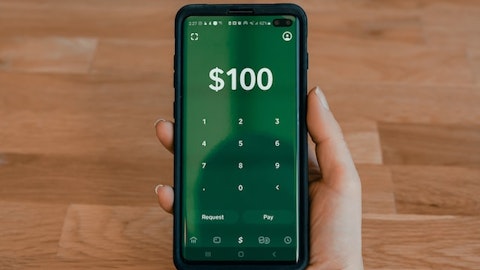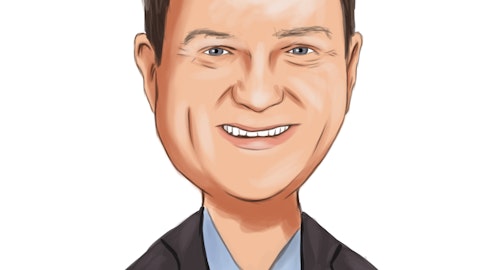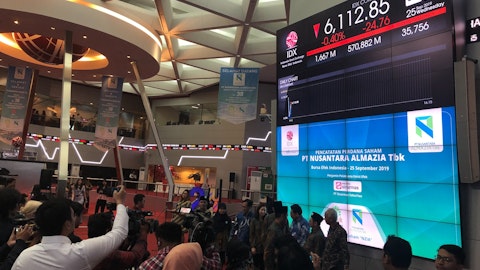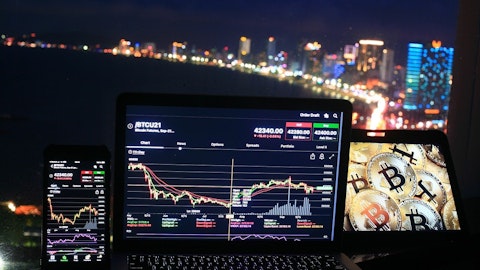Woori Financial Group Inc. (NYSE:WF) Q1 2023 Earnings Call Transcript February 6, 2024
Woori Financial Group Inc. isn’t one of the 30 most popular stocks among hedge funds at the end of the third quarter (see the details here).
Han Hong Sung: Good afternoon. I am Han Hong Sung, Head of IR at Woori Financial Group. Let me first begin by thanking everyone for taking time to participate on this Earnings Call for Woori Financial Group. On today’s call, we have Group’s CFO, Lee Sung-Wook; Group CRO, Park Jang-Geun; and Group CDO, Ouk Il-Jin, participating. For today’s call, the CFO, Lee Sung-Wook, will present the earnings performance and Woori Financial Group’s capital management plan, after which the CRO, Park Jang-Geun, will walk you through an overview of the Group’s risk management efforts; and at the end, we will have a Q&A session. In addition, please note that today’s call is being interpreted simultaneously for our overseas investors. Now, let us start the presentation of Woori Financial Group 2023 business performance.
Lee Sung-Wook: Good afternoon. I am Lee Sung-Wook, CFO of Woori Financial Group. Let me dive into the 2023 performance of our group. Based on the presentation, which is available on our website, please turn to Page 3. First, let me discuss the Group’s 2023 profit and losses. In 2023, Woori Financial Group’s net income was KRW2,516.7 billion, representing a 19.9% decrease year-over-year. The decline in net income was due to mainly one-off factors such as preemptive provisions by changing the credit cost calculation components, strengthening the loss absorption capabilities of vulnerable areas within the non-bank subsidiaries, and expenses related to corporate and finance programs. Following the steep rise in interest rates, the higher for longer environment has led to increasing concerns by the market on the quality of high risk assets such as real estate project finance and loans to vulnerable borrowers.

We have been focusing on our efforts in the fourth quarter to ensure we preemptively address these market concerns. On the bank side, we adjusted the assumptions that go into our credit cost, such as the LGD and PD values to reflect the future economic outlook. In addition, in the non-bank side, we conducted a comprehensive examination on vulnerable areas to actively set aside provisions, and during the fourth quarter, these activities led to approximately KRW525 billion in additional one-off credit. In addition to actively participate in extending cooperative finance, we approximately KRW170 billion in other operating expenses were recognized in the fourth quarter. When excluding these one-off factors, the Group continues to maintain solid profit generating capabilities.
Based on our enhanced loss absorption capabilities in 2024, we will strengthen our fundamental competitiveness and intergroup synergies to further solidify our performance improvements. Next, let me move on to the expenses including our SG&A and credit cost. The Group’s 2023 Group SG&A was KRW4,443.9 billion. Though inflationary pressure continued, it decreased 1.9% year-over-year. The cost income ratio was 43.5%, which is a 0.9% point decrease versus the previous year, and it has been being maintained at a stable level. On the Group credit cost, including, for the fourth quarter, KRW802.2 billion, for the full year of 2023, the Group provisioned KRW1,880.7 billion, which is around two times higher year-over-year, which we believe represents sufficient loss absorption capabilities.
When excluding the one off factors that we mentioned before related to preemptive risk management, the normalized credit cost ratio is 0.32%. As a result of actively dealing with future uncertainties, the Group MPL ratio is 0.35%, and the MPL coverage ratio, which is an indicator of loss absorption capabilities, is 229%, the highest level to date. Next, let me move on to discuss our capital ratios and dividends. As of the end of 2023, the Group’s CET1 ratio is expected to be 11.9%. This is a result of prudent management on risk weighted assets and is a 0.3% increase versus the end of the previous year. In addition, during the Group BoD meeting today, in consideration of the financial performance and the Group’s mid- to long-term plans, the Board decided on a year-end dividend of KRW641 per share for 2023.
See also Jim Cramer’s 11 Latest Stock Picks and 11 Best Regional Bank Dividend Stocks to Buy.
Q&A Session
Follow Woori Financial Group Inc. (NYSE:WF)
Follow Woori Financial Group Inc. (NYSE:WF)
When including quarterly dividends of KRW361, it becomes KRW1,001 per share. In addition to modernize the dividend policy, the reference date for the 2023 year dividends has been determined to be February 29. When excluding the 100 billion share buyback and cancellation conducted during the year, Woori Financial Group total shareholder return rate is 33.7%, which is a significant increase versus the previous year. After the earnings presentation, I will provide you with additional information on our new capital management policy and mid- to long-term shareholder return policy. Next, let me delve into the performance of each area in more detail. Please refer to Page 4 of the presentation. First is interest income and net interest margin, or NIM.
The Group’s 2023 net interest income totaled KRW8,742.5 billion, similar to the prior year. And in the fourth quarter, the net interest income was KRW2,142.6 billion, a 2% decrease Q-o-Q. Woori Bank’s 2023 NIM was 1.56%, and the group NIM, including the credit card business was 1.82%. The NIM of the bank and the group fell three basis points and two basis points, respectively, versus 2022. Amid a high interest rate environment, the portion of low-cost core deposits increased significantly – decreased significantly, resulting in a continued increase in funding cost, which was one of the main drivers behind the weaker margins. This year, we will be entering a rate-cutting cycle. And thus, we expect the backdrop will be challenging from a profitability perspective.
However, low-cost core deposits have recently recovered and the interest on time deposits is declining. We will continue to focus our efforts on improving our funding cost and defend our margins. Next, let me talk about asset growth and the loan book. The total loans of the bank as of the end of 2023 totaled KRW311 trillion, which is a 5.1% increase year-over-year. On the corporate loan side, the large corporate loan demand was very strong, with high quality SME loan growth, also very solid, leading to corporate loans posting KRW170 trillion, up by 8% Y-o-Y. On the other hand, retail loans was KRW136 trillion, an increase of 1.9% Y-o-Y as growth was driven by real demand mortgage loans due to the effects of the government’s household debt management policy.
This year, the group will diligently execute its role as a liquidity supplier in light of the economic situation. But as uncertainties at home and abroad are still looming large, we are planning to focus our portfolio growth on high quality assets with a consideration of our risk weights to achieve profitable growth. Next, let me talk about the group noninterest income. The group’s 2023 noninterest income was KRW1,094.8 billion, a decrease of 4.7% Y-o-Y. This includes the support we will extend to cooperative finance, and when excluding this amount, non-interest income grew 10% YoY. In addition, core fee income each quarter is recording a mid KRW400 billion level, representing a solid growth trend. As intergroup synergies are realized in full, the fee income contribution of non-bank subsidiaries such as credit card trust and capital business has grown a lot versus the early days of the holding companies.
In 2024, the group is planning to actively pursue HQ sales in the areas of FX and derivatives, and marketable securities and asset management will be focusing on wealth management. The bank will become a leader in the asset management market by creating an upgraded product lineup and portfolio enhancing sales capabilities by increasing the channel specialized in asset management and utilizing its existing robust product risk management system. Next, let me move on to expenses and capital adequacy, please look at Page 5. This is the SG&A. The group’s SG&A in 2023 was KRW4,443.9 billion, and although inflationary pressure continued, the SG&A was down by 1.9% year-over-year. In addition, the cost income ratio recorded 43.5%, a decrease of 0.9 percent point year-over-year, maintaining a three-year continuous and consecutive decline.
Due to consistent efforts to rationalize personnel, labor costs decreased 6.3% YoY, and in addition, even though new subsidiaries like Woori Venture Partners was added, general and administrative cost only grew slightly versus the previous year. As the top line growth will be challenging, we believe it is important to focus on cost management in the current conditions. The group has kept recurring expenses outside of future core businesses flat and while also continuing to rationalize channels and personnel such company-wide cost saving efforts will be strengthened further going forward. Next is credit cost. In 2023, the group’s credit cost was KRW1,880.7 billion for the full year and KRW802.2 billion for the fourth quarter. In the first half of the year, Woori Financial Group executed preemptive provisioning of KRW263 billion, reflecting adjustments to the future economic outlook, and in the fourth quarter, the banking business in consideration of changes in credit cost calculation components such as real estate LGD values, set aside KRW229 billion in preemptive provisions and to enhance loss absorption capacity in vulnerable sectors, the non-banking side added provisions of approximately KRW200 billion.
And when adding the provisioning of KRW96 billion related to Taeyoung E&C, which recently filed for a debt workout, the total of additional credit costs recognized stands at approximately KRW525 billion, putting the group at a stronger position to respond to future economic conditions. As a result, the groups and the bank’s NPL coverage ratios are at record high levels of 229% and 318%, respectively, and the NPL ratio is stably managed at 0.35% and 0.18%. Meanwhile, the group’s credit cost ratio is 0.53%, but excluding the one off factors mentioned – aforementioned, the current credit cost ratio is at 0.32% level. Considering the risk of default in real estate PF loans and the rising delinquency rate in the non-banking side, concerns about the soundness of the market are likely to persist for some time.





